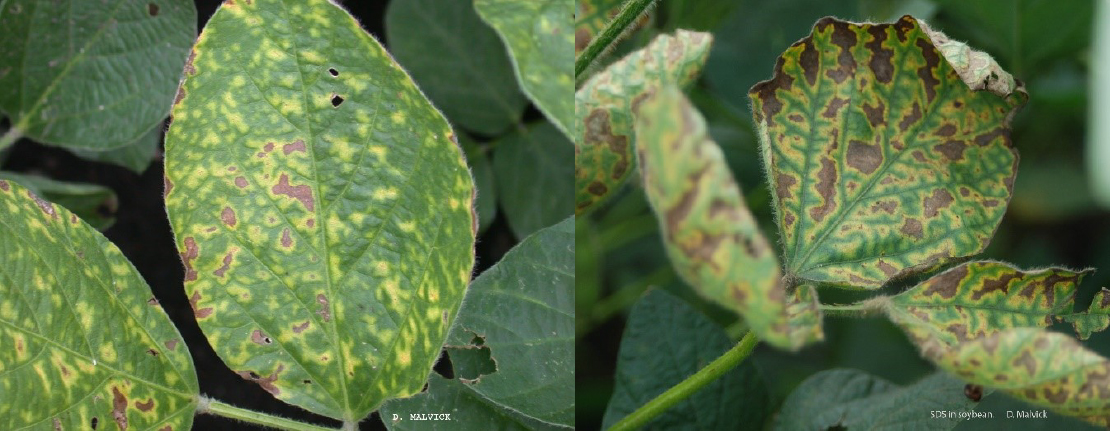August 28, 2019
Soybean Sudden Death Syndrome (SDS), caused by the invasive soilborne fungus Fusarium virguliforme, has been somewhat of a mystery since it was first detected in the United States in the 1970s. It was first found in southern Minnesota in 2003. Since then, it has been spreading and has been confirmed as far north as Ottertail County, not far from Alexandria, Minnesota. The fungus also causes root rot on dry edible bean and other legumes. Yield losses in affected crops can reach 50%.
F. virguliforme has been identified as a priority species for research by the Minnesota Invasive Terrestrial Plants & Pests Center. At the forefront are questions about the distribution of the disease – where it is developing and why.
“It strikes me that we don’t really know that much about the fundamental things like its survival ability and basic biology,” said Kathryn Bushley, assistant professor in the Department of Plant and Microbial Biology and a co-investigator on an MITPPC-funded project designed to improve our understanding of F. virguliforme and SDS ecology.
The rest of the team – plant pathologist Dean Malvick, post-doc Rod Olarte and master's student Rebecca Hall – has come across preliminary evidence that the disease-causing fungus may have spread even farther north in recent years. They are doing survey work to determine distribution in the northwestern part of the state.
A growing problem
Malvick has been researching SDS and F. virguliforme for over 12 years, trying to learn more about one of the most important soybean production problems in southern Minnesota.
“The ultimate goal is to improve our understanding of the biology and risk of SDS across Minnesota so we can better manage and mitigate the problems. We’re also trying to understand what differences may occur further in the south where it’s been a problem for longer,” he said.
As the disease continues to spread, the team continues to look for answers as to what might allow it to establish in a field. Because it has mainly been an issue in southern Minnesota, northern growers have prioritized other diseases for management solutions. The farther north you go, the fewer disease management options there are for SDS.

Symptoms of soybean sudden death syndrome (SDS) at its early (left) and late (right) stages. (Credit: Dean Malvick)
“To really manage SDS in the long term, we need a better understanding of it. If we know where it’s occurring and what its risk might be in those areas, it will help growers with proactive management,” said Malvick.
The work of Malvick's team includes experiments that examine the two-way interaction between plant and the pathogen, but the two don’t always work together nicely.
“Not only are we trying to work with a fungus, but we’re also trying to work with a variety of different potential host plant species that are not always easy to grow for experiments,” said Hall.
“If we continue having wet summers, I think there is potential for SDS becoming more of an issue in more areas.”
As the weather continues to change over time, SDS might become more of an issue. The disease tends to thrive in wet environments.
“If we continue having wet summers, I think there is potential of SDS becoming more of an issue in more areas,” said Malvick.
Can SDS weather Minnesota winters?
Hall has focused on the effects of cold stress has on F. virguliforme, and she hopes to pinpoint the lowest temperatures that the pathogen can still survive. The data she collects will help researchers estimate how likely it is for the pathogen to survive in the soil through ever-warming winters.
“The summer rainfall pattern favors the disease. If the winters truly are warmer, or at least if we don’t have a lot of extremely sub-zero weather, the SDS pathogen may have a greater chance of surviving. It may increase the risk,” said Malvick.
Many soybean varieties have some level of resistance to SDS, but the trend is inconsistent. For example, few northern climate-adapted soybean lines (used by growers in the northern part of the state) are highly resistant.
“Resistance is not an absolute plus or minus. It’s on a scale. There are a good number that have a high level of resistance, but there is still a great number with low levels of resistance,” said Malvick.
A seed treatment for SDS has also been on the market for around 3-4 years, which has proven an effective management tool for growers. Other products are likely to be registered and available soon.
Past research and field observations also suggest that soybean cyst nematode, a plant-parasitic roundworm that attacks the roots of soybeans, is sometimes correlated to SDS infection.
“I would say the entire association between SDS and SCN is still not well understood. We’re working on methods to actually test it,” said Olarte.
It is possible that the cysts that grow from SCN fall off into the soil, providing an environment for SDS to colonize them. Another possibility is that the stress put on the plant by the cysts causes the infection of SDS to progress. Malvick and his team are taking a look at these connections but are still in the early stages of the work.
“I feel like this work will directly impact management for farmers,” said Hall.
“I feel like our work will directly impact management for farmers.”
The team is currently calling on you for plant samples to enable them to determine where the pathogen is spreading in the northern half of Minnesota. If you would like to aid in the research of this disease, click this link to find the sampling steps for detection of F. virguliforme.
Funding for this project was provided by the Environment and Natural Resources Trust Fund as recommended by the Legislative and Citizen Commission for Minnesota Resources.
Learn how you can aid in Minnesota SDS research and receive free soybean disease sampling at this link.
Also check out our 'Meet the Researcher' Q+A with Rebecca Hall.

About the Author
Maggie Nesbit is a Communications Intern with the Minnesota Invasive Terrestrial Plants and Pests Center (MITPPC). She is a double major in English and Strategic Communications at the University of Minnesota. In her spare time, Maggie enjoys running, hiking, reading and spending time with friends and family. Maggie's position is funded by a grant from the Minnesota Soybean Research & Promotion Council.